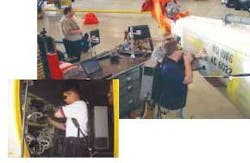Marking manages inventory
The logistics of moving mass quantities of military goods around the world in two or three weeks can stress the inventory management of the U.S. government to the full extent. It is difficult to estimate the hardware, repair and replacement parts, and mission critical parts that are used to support a military operation. If the labels and paperwork become separated from these parts they become lost, scrapped, stolen, and sometimes find their way back into the supply chain. A General Accounting Office (GAO) study estimated the Department of Defense (DoD) could have saved $2 billion dollars, from the $2.7 billion dollars spent, through better information about available inventory.1
Today the U.S. is faced with a similar problem; we have moved mass quantities of our military halfway around the world and are faced with the inventory, supply, and logistics of a war. In an attempt to solve this problem, Unique Identifier (UID)—a process of affixing a uniquely identifiable number to military parts that meet certain criteria—has been implemented. In effect each part is given its own social security number. UID provides the military with the opportunity to differentiate an item from all others throughout the DoD supply chain from acquisition to the termination of the individual part.
In a pilot program at the U.S. Coast Guard (USCG) Aircraft Repair and Supply Center (Elizabeth City, NC), Monode Marking Products Inc. (Cleveland, OH) and Robotic Visioning Systems Inc. (RVSI; Nashua, NH) had the opportunity to test many new marking technologies and to find ways to improve upon existing technologies. The USCG is a multi-mission federal agency charged with a role in national defense, regulatory law-enforcement, and emergency response duty. Under the Department of Homeland Defense the Aircraft Repair and Supply Center at Elizabeth City provides the USCG with supply and maintenance services for all Coast Guard facilities.
RVSI Acuity Ci-Matrix, the inventor of Data Matrix symbology and Code 128, is a world leader in providing machine vision systems, barcode, and advanced two-dimensional symbology readers for manufacturing and distribution environments.
The program consisted of affixing 2D data matrix codes to 50 different safety and flight-critical aircraft parts. The 2D data matrix complies with the new UID directive that went into effect on January 1, 2004. One problem was how to mark all the different substrates with the different configuration of parts. Because there was not one particular process that could be used for such a wide array of parts, the Monode FRL laser was the most practical solution. The FRL laser delivers a high-power laser beam directly to the work site via a metal-sheathed fiber-optic cable. The fiber-based technology and rugged design allow for easy integration and the ability to operate in an industrial application in respect to shock, vibration, dust, humidity, and temperature.
Many of these parts were so large they would not fit into or under many of the traditional marking machines that currently exist. So, taking the marker to the part became the answer because of the fiber-optic delivery system. With the addition of a backpack, the marking head has taken on the characteristics of a portable marking system. This unique feature provides usability, versatility, and practicality. With the addition of a base plate and column this unit can become a fixed-station laser, essentially giving users two laser marking systems.
The Monode FRL laser is a step forward in the marking industry offering users many appealing features: 50,000+ hours of trouble-free diode service life; red laser pointer for locating start point; air-cooled operation; 10-, 20-, and 25W power options Q-switched or CW; PLC interface for integrated applications; operator-friendly software; and competitive pricing. The versatility of the fiber laser enables Monode to perform several different types of marking as well as laser bonding, paint removal, stencil cutting, and label making.
Monode Marking Products, incorporated in Cleveland in 1956, is a world leader in electro-chemical etching, steel stamp manufacturing, distribution of equipment for plastic decorating by hot stamp and pad printing, and SIC pin-marking.
When identification is critical for traceability or product impact, a quality mark is required. Monode combines creative engineering with a range of marking solutions.
Reference
- Automatic I.D. News, Sept. 99, Vol. 15 Issue 10, pg. 36 (The GAO report was issued in September 1992).
Jeremi Woodruff handles laser sales for Monode. Contact him at [email protected].

